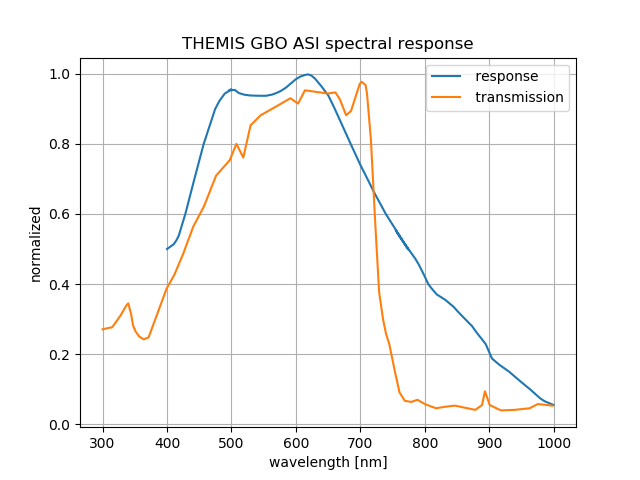Read & plot 256x256 "high resolution" THEMIS ASI ground-based imager data from Python. THEMIS ASI data are collected with the original 2002 design, using Starlight-Xpress Lodestar MX716 cameras with monochrome Sony ICX249AL imaging chips. A subregion from full-size 752 x 582 pixels (512 x 512 pixels) are 2x2 binned to 256 x 256 pixels and retrieved over USB 1.1 for disk storage.
This package also reads the THEMIS ASI star registered plate scale, giving azimuth and elevation for each pixel.
git clone https://github.com/space-physics/themisasi
pip install -e themisasiOptionally test the basic functionality by:
pytest themisasiOne of the main ways analysts might use THEMIS-ASI data is by loading it into a 3-D array (time, x, y).
This example is where the ASI video files are in ~/data/themis, and the Gakona site is selected at the time shown.
import themisasi as ta
dat = ta.load('~/data/themis', site='gako', treq='2011-01-06T17:00:03')This returns the camera image from Gakona camera closest to the requested time, and the 'az', 'el' calibration data, if available.
THEMIS-ASI output xarray.Dataset, which is used throughout geosciences and astronomy. Xarray may be thought of as a "smart" Numpy array, or a multidimensional Pandas array. A THEMIS image data stack is obtained by:
dat = ta.load(...)
imgs = dat['imgs']dat.timecontains the approximate time of each image (consider the finite exposure time).dat.xanddat.yare simple pixel indices, perhaps not often needed.
Loading calibration data gives azimuth, elevation for each pixel and lat, lon of each camera.
import themisasi as ta
dat = ta.load('~/data/themis', site='gako', treq='2011-01-06T17:00:03')If an appropriate calibration file exists, dat additionally contains 'az', 'el', 'lat', 'lon' and so on to allow using data for multi-camera analyses.
If desired, convert azimuth/elevation to ra/dec using pymap3d.
pip install pymap3dand then from within Python:
import pymap3d as pm
rasc, decl = pm.azel2radec(dat.az, dat.el, dat.lat, dat.lon, dat.time)The data is downloaded concurrently using asyncio and aiohttp_requests.
There is one concurrent worker launched per site, that downloads one time at a time concurrently across sites.
Thus if downloading for one site, one time downloads at a time.
If downloading for 5 sites, five files download at a time across requested times by site.
Get video data from Themis all-sky imager
data repository.
The
plate scale
data is also downloaded.
The calibration files are named *asc*.cdf or *skymap*.sav.
Example: February 4, 2012, 8 UT Gakona
python -m themisasi.download 2012-02-04T08 gako ~/dataor via the API:
import themisasi as ta
ta.download('2012-02-04T08', 'gako', '~/data')with the API, it is convenient to for-loop over many sites at the same time(s):
sites = ['fykn', 'gako']
for site in sites:
ta.download('2012-02-04T08', site, '~/data')With the calibration data, verify that the time range of the calibration data is appropriate for the time range of the image data. For example, calibration data from 1999 may not be valid for 2018 if the camera was ever moved in the enclosure during maintanence.dib-lab/khmer#1430
You can optionally download from within Python:
import themisasi as ta
ta.download('2012-03-12T12', 'fykn', '~/data')the convenience function themisasi.io.filetimes(filename) returns a list of Python datetime in a file
This example plays the video content.
Use the -o option to dump the frames to individual PNGs for easier back-and-forth viewing.
The calibration file (second filename) is optional.
python -m themisasi.video ~/data/themis/thg_l1_asf_fykn_2013041408_v01.cdfAgain, be sure the calibration file is appropriate for the time range of the video--the camera may have been moved / reoriented during maintenance.
The pixels can be specified by (azimuth, elevation) or (lat, lon, projection altitude [km])
Azimuth / Elevation:
python -m themisasi.pixels tests/thg_l1_ast_gako_20110505_v01.cdf -az 65 70 -el 48 68Latitude, Longitude, Projection Altitude [kilometers]: Typically the brightest aurora is in the 100-110 km altitude range, so a common approximate is to assume "all" of the brightness comes from a single altitude in this region.
python -m themisasi.pixels tests/thg_l1_ast_gako_20110505_v01.cdf -lla 65 -145 100.Themis site map (2009)
THEMIS GBO ASI spectral response:
These articles give vital descriptions of THEMIS GBO ASI.
- Mende 2008 SSR
- color instrument based on Themis: Jackel 2014
- Themis GBO ASI site coordinates
- THEMIS GBO ASI plate scale
- THEMIS GBO ASI plate scale
- Themis GBO ASI data repository
- Themis GBO ASI mosaic (all sites together)
I discovered that IDL 8.0 had a problem saving structured arrays of bytes. While current versions of IDL can read these corrupted .sav files, GDL 0.9.4 and SciPy 0.16.1 cannot. My patch is part of SciPy to allow reading these files, which was incorporated into SciPy 0.18.0.
As a fallback, read and rewrite the corrupted file with the IDL script in the idl directory.


